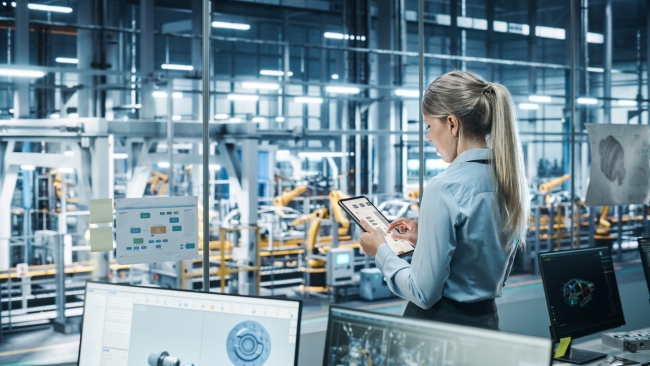With input costs soaring, manufacturers need to be laser-focused on reducing production losses, increasing throughput and resolving issues faster. In the face of extreme supplier shortages, record inflation and fluctuating demand, operational efficiency is vital for survival and growth.
The companies most likely to succeed are those who adapt their processes, digitalise their systems and embrace new technologies. This blog will take you through the top 10 ways that manufacturers can increase production efficiency, including how you can implement our production monitoring software completely free of cost!
Examine Factory Workflow
Start by taking a close look at your current workflow. Identify areas where processes can be streamlined or improved. Are there frequent changeovers that are eating into production time? Could these be made more efficient? Are we updating technology and causing disruption when it's not needed? By examining your entire workflow, you can identify areas that need to improved or removed, which will in turn improve efficiency.
Address Production Bottlenecks
Bottlenecks, whether they're slow manual processes or machinery that often breaks down, can significantly hamper production efficiency. Most people assume that machine related issues are the biggest causes of production bottlenecks, but it's actually human related issues.
The most common human related bottlenecks include taking too long to repair a machine and missing signs of machine wear and tear. By pinpointing these areas and addressing them - through faster problem resolution or machinery upgrades - you can smooth out these kinks in the production line.

Optimise Factory Conditions
Your factory's environment plays a crucial role in efficiency. Certain factory's require certain conditions, such as a factory producing ice cream needs very cold temperatures. Temperature and lighting can impact both machine performance and employee productivity.
Creating an environment that satisfy's the needs of the product, but also the needs of the employee, will improve efficiency. Ensure these are optimised for the best working conditions, keeping in mind both efficiency and safety standards.
Invest in Automation
Automation is a game-changer in manufacturing. Relying on humans increases costs and prevents scalability. Evaluate which processes can be automated to reduce manual errors and increase efficiency. While investing in advanced technology may have high upfront costs, the long-term benefits of consistent quality and reduced labour costs make it well worth it.
Similarly, you must upgrade your technology when it needs it. Say you are missing out on just 3 minutes activity per day due to poor loading speeds. It doesn't sound like much, but that's 18.25 hours per year. If your factory produces £10,000 worth of revenue in 1 hour, that's a whopping £182,500 per year that you are missing out on! Invest in your systems and you will reap the benefits.
Upskill your Workforce
A skilled workforce is a productive one. Despite what some people may think, improving efficiency doesn't mean getting rid of all humans and replacing them with technology. You can make significant gains simply from teaching your workforce new skills.
Regular training programs are therefore essential to efficiency, making employees more adaptable to new technologies and processes. For example, training your employees to identify early signs of machine failure means they can implement preventative maintenance and will save huge amounts of downtime. This not only improves efficiency but also boosts employee morale and job satisfaction.

Implement Preventive Maintenance
As we've just mentioned, routine maintenance can prevent unexpected machine downtime. Establish a preventive maintenance schedule that consistently monitors and improves the health of your machinery. This proactive approach can save both time and money in the long run.
Reduce Waste
Waste reduction is a critical aspect of efficient production. Implement strategies to minimise material waste and make the best use of resources. This can involve recycling materials, rethinking production processes to be more resource-efficient or even selling the waste as a further product and increasing revenue this way.
Focus on Quality
Many think that production efficiency refers to producing as many units as possible, but this is not the case. Productivity refers to the number of units produced, efficiency refers to the number of units that can be sold, which means quality is a big factor within the equation.
As such, quality should never be sacrificed for speed. Implement quality control checks throughout the production process to ensure the final product meets the desired standards. This reduces the cost and time associated with reworking or discarding defective products.
Create Standard Operating Procedures (SOPs)
Clear and concise SOPs ensure that everyone is on the same page and processes are carried out consistently. They are particularly useful for training new staff, as they set out clear processes and reduce the amount of mistakes people make early on. SOPs must also be regularly updated to reflect any changes in technology or process.
Collect and Analyse Data
This is arguably the most important way to improve efficiency. Without data, you won't easily be able to implement the above strategies. You will struggle to identify where the bottlenecks are, you won't understand what's causing them and creating accurate preventative maintenance schedules will be harder. Implementing a manufacturing analytics tool will do all of this for you.
This is where we come in. Busroot is our performance monitoring and analysis platform that connects existing assets to the cloud to create an accurate and real-time overview of factory performance. Through pre-built, easy-to-understand visualisations and workflows, managers can minimise downtime, maximise throughput and easily manage incidents on any device.
At any given time, you will be able to see whether a machine is producing or not, and if it’s not, the reason why. If your factory has 10 machines, we can effectively add an 11th ‘virtual machine’ through performance gains and optimising how issues are resolved. That’s an immediate 10% boost to your productivity without the need to go out and acquire additional machines or workers. What's even better, we are offering 25 manufacturers the chance to implement Busroot completely free of cost thanks to innovative funding from MakeUK. Check out our Lighthouse Project page for more information and to register your interest in this amazing opportunity.
Want to find out more about Busroot? Book a demo with us now to see how we can help your business!



